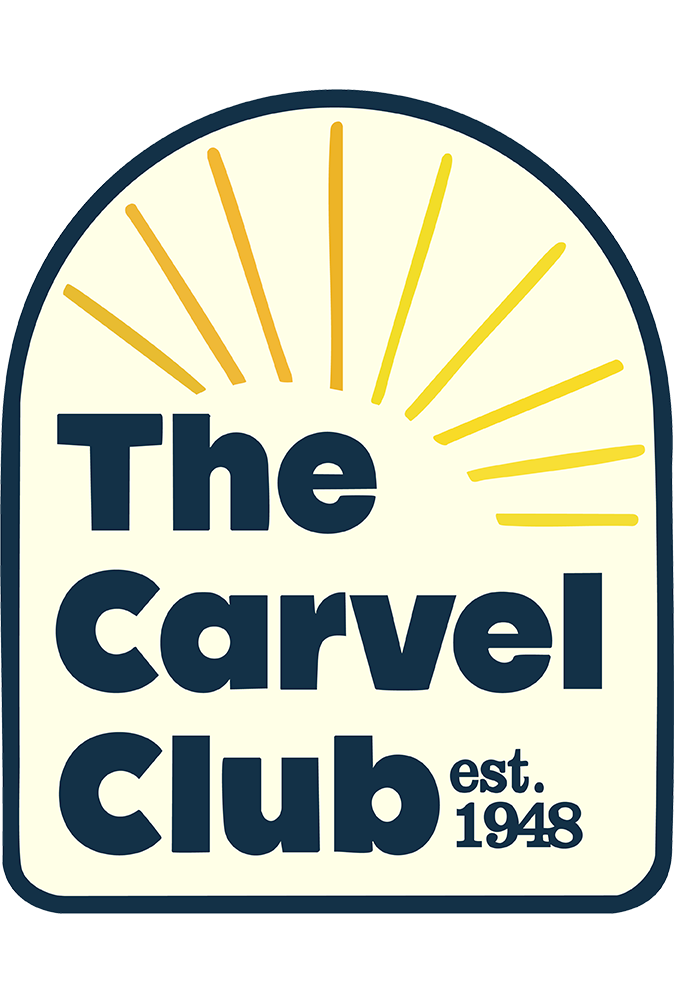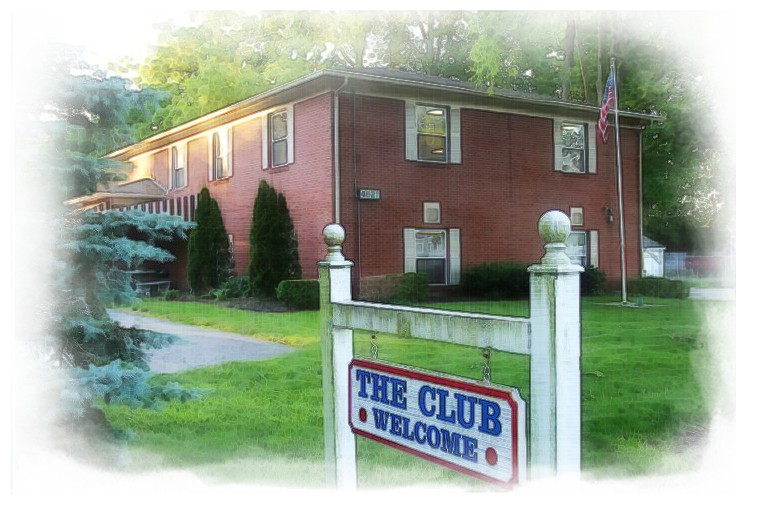History of The Carvel Club
A Club is Born
If there is a central thread that runs through virtually the entire history of Alcoholics Anonymous in Indianapolis it surely must be the role that “The Club” has played in AA life. It was founded by the growing body of recovering alcoholics in Indianapolis who needed a place to gather, a center for their new, sober but not somber social life.
Originally called The Alanon Club, it was renamed “The Club” a few years ago, then became The Carvel Club.
In January 1948, a small group of recovering alcoholics met in the home of Dr. Beck to discuss the idea of a club, an idea carried to Indianapolis by Reg G. and Harry L., who had seen a club of this type in Des Moines, Iowa.
These folks didn’t just talk, they acted. With $100 donations from a small group of men, a three-story building at 124 West Georgia Street was rented. Furniture was donated to equip the rooms, draperies were made by the wives, and other supporters were at work cleaning, painting, hammering, and preparing the new club rooms.
The Alanon Club was opened April 3, 1948, making it one of the oldest, and most successful, such clubs in the world. Interestingly, the original incorporated name of “The Alanon Club” actually preceded the formal use of the term Alanon to refer to family groups helping those affected by our disease.

Among those who started the club were George D., Charles R., James K., Vaughn B., Willie F., Lovett G., Dr. Beck, and others. Unfortunately it is impossible to recapture the names of all those who played a role in starting The Club, but it appears certain that AA pioneers like Doherty S. who brought AA to Indianapolis, the famous alcoholic priest Father Ralph P. (known as “Father John Doe” in his writings), along with Sam T., Charlie T., Wade F., Walter H., Hugh D., Vernon Q., and Bill C. and others were either involved from the very beginning or shortly afterward.
The first Club President was Charles R., and Harry L. was the first manager.
“It Ain’t Much but It’s Home”
There was nothing very fancy about The Alanon Club, but it was a joyous and active gathering place, a safe haven for those who needed AA. There were bake sales, dances, pitch-in dinners, ping-pong, card games, a pool table . . . and there were meetings! In 1950, there were four meetings a week at The Club, and perhaps only 10 or 12 more throughout the city.
It was located in a not-exactly-thriving part of downtown Indianapolis…not exactly the slums, but it certainly wasn’t the “best” part of downtown, and there was a Salvation Army shelter across the street. Nevertheless, it clearly was the center of AA activity in the city.
Today, that same site is at the heart of the busiest part of all Indianapolis, immediately between the RCA Dome and Circle Centre Mall!
The walls were so thin you could hear the people on the other side as they argued at Intergroup Meetings, recalled one old-timer. Another remembers a square dance upstairs that was so energetic the folks below thought the ceiling would fall in.
One of the earliest women in AA in Indianapolis, Zu R., who helped literally thousands of alcoholics in her role as secretary of the Central Office, once said, “I remember kicking wine bottles away from the front door to get in some mornings.”
In Search of a Place to Establish Roots
In the early 1950s the Central Office was located in the Club building (it previously had been run out of an AA member’s home). In 1955 the Central Office moved into the Peoples Bank Building, and at about the same time the Alanon Club moved north, to 2209 Central Avenue, where it remained for about five years.
The new club location was an old house (now gone), but it was the location of a whirlwind of activity, with dances, bake sales, card parties, and weekly bingo games. As the number of meetings throughout the city grew, the meetings at The Club declined for a while, but the facility was the meeting place for alcoholics on their way to work in the morning, at lunch, and on their way home after work.
Then comes a strange sidelight in Club history that has been virtually forgotten – to the point that even people who have been part of The Alanon Club life and history for 20 to 25 years do not know: the Alanon Club moved into a former bar on North Meridian Street! It was a brief occupancy, while another location was sought, but for a few months The Alanon Club was in an old bar and dinner club (famous in the ‘50s) on the west side of Meridian, just above 22nd Street.
Welcome to the Neighborhood
The next stop was 4627 Carvel, today’s home. Initially, The Club was in an old red brick house at the back of the property, right in the middle of what is today’s main parking lot. It was so small that it is difficult to conceive of all the activities there. The kitchen was open all day, and meetings were held virtually every day of the week. How 50 or 60 people could crowd in for weekly bingo games, pie suppers and similar activities is almost inconceivable. At that time virtually everyone in AA smoked, and the ventilation left a lot to be desired.
There was a tremendous amount of sobriety built in those humble surroundings, a place where everyone was welcome and “oldtimers” were only too glad to share their experience, strength, and hope with shaking newcomers.
During this time, Al and Edie S. took over management of The Club, hiring “refugees” from the streets who worked for room and board. Also working in the kitchen was Daisy R., who even provided an informal “wake-up call” service for newly sober members, calling them at home at 6 or 6:30 so they could run to the club for breakfast and then head off to work. Edie’s two teenage daughters often were pressed into service in the kitchen, or as waitresses.
Al and Edie managed The Club while it was in the old brick house for several years in the early 1960s, and then left. Other managers at this time included Lawton H., Charlie and Ma B. and Harold and Betty H. In the early 1970s Al had remarried and returned to The Club with his new wife, Mary, to serve as managers for the next 14 years.
A Place Called Home
As activities and membership expanded. The Club outgrew the physical limitations of the old building. A massive fund-raising effort under the leadership of Dr. Don B. brought in widespread community support, and in 1968 The Club moved into the beautiful two-story building that is today’s home.
Later The Club acquired property to the south at the corner of 46 th Street and Carvel, including the old white house which was first used as a residence for Al and Mary S. and later became the home of non-smoking meetings in 1989. Purchase of that property was made possible through contributions by a small group of anonymous donors. Then a small house to the north side of the property – where the north parking lot is located now – was purchased by Julia B. and donated to The Club.
By 1973, a quarter century after The Club was founded, there were 10 meetings held each week. At that time there were just 50 meetings in the entire city.
The original old brick house survived for several years, as a “dormitory” for the men working at The Club. Eventually it became too rundown to maintain and space was needed for parking. It was demolished about 1990. When the building was razed, workers found a cellar space that was jammed with empty whiskey, wine, and beer bottles – proving once again that despite all the supervision exercised over the residents, alcoholics who want to drink will always find a
way to do so.
The new facilities were impressive, and booming membership brought a lot of changes in life at and around The Club. Eventually the kitchen was enlarged, and for several years, friends would meet there for dinner, sometimes with as many as 20 or 30 men joined in fellowship at a long communal dinner table before completing their evening with an AA meeting. An ever-popular menu item was the famous “Alanon Steak”, a large and glorified hamburger steak fancied up with peppers and onions. The food was good and cheap.
However, changing living, work, and travel patterns in and around Indy brought changes to The Club. Where at one time most northsiders drove close to The Club on their way to work in the morning, and home at night – stopping both ways for coffee and supportive fellowship – now their jobs no longer brought them downtown so these important daily respites were no longer possible.
Yet The Club thrived – and continues to do so — with more than 35 meetings a week. Frequently there are multiple meetings underway at the same time. One of the greatest strengths of The Club and its leadership is flexibility and willingness to compromise and adapt to changing conditions and changing needs of members and all others who use The Club.
While in early days, the old Alanon Club frequently needed the contributions from a small band of strong and anonymous supporters for its very survival. Under today’s leadership, The Club is financially sound and developing long-range programs to ensure that it flourishes into the new millennium.
It’s a “We” Program
It is impossible to honor everyone who saw The Club through its early years, but it would be more unfair not to mention those whose names are available.
The Club was well served by countless folks like Buck B. and Bob M., presidents during times of great change, along with many others who made major contributions of time, money, and effort. Included should be people like Peg B., Al and Carolyn A., Joe K., Don and Helen B., Hank S., Wayne and Marion G., Wally D., Walker D., Alex V., Francis S., Wally W., Charlie and Helen M., Bob and Katie G., Julia B., Tom F., Tom G and Art C.
During its long history there have been many dedicated managers and employees, some of them for long periods and others only briefly. Among the most memorable long-time employees, working at times in the 60s, 70s and 80s, was Clarence L., known for his natty dress and devotion to the New York Yankees. For many years Clarence Just couldn’t seem to reach a one-year anniversary, but finally he had seven successful years when he died.
Other managers in the 1980s included Jack M., Gene G., Paul O., and John L, all playing an important role during those years of great change. Paul was the initiator of the colorful “Wall of Gratitude”, a money-raising venture that helped support The Club and since has been “cloned” in other clubs as far away as California and Florida.
From the early 1990s to today, The Club has been managed, successively, by Bob N., Doug B., Jim B. and, as of 2023, by Grant S.
Under the stewardship of a dedicated staff and the board of directors, The Carvel Club continues to thrive and is poised to serve residents of Central Indiana who seek and embrace recovery for decades to come. The Club’s loyal members as well as guests take to heart the message that greets them each time they enter the parking lot and the building…

